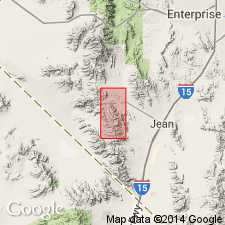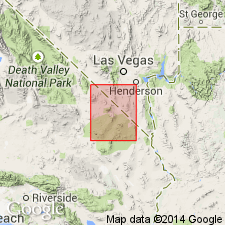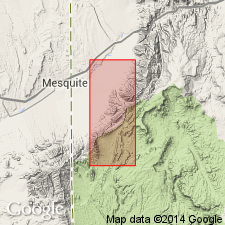
- Usage in publication:
-
- Arrowhead limestone member*
- Modifications:
-
- Named
- Dominant lithology:
-
- Limestone
- AAPG geologic province:
-
- Great Basin province
Summary:
Named for Arrowhead prospect sec.9 T24S R58E, Goodsprings quad, Clark Co, NV-San Bernardino Co, CA. [no type designated] Included as second youngest member of Monte Cristo limestone (new). Occurs throughout range north of Columbia Pass and near Ingomar mine. Consists of alternating layers of blue and gray limestone 2 to 4 in. thick and thinner layers of gray shale. Contains abundant fossils of middle[!] Mississippian age. Overlies Bullion dolomite member (new) and underlies Yellowpine limestone member (new) (both of Monte Cristo limestone. Is considered middle[!] Mississippian age.
Source: GNU records (USGS DDS-6; Menlo GNULEX).

- Usage in publication:
-
- Arrowhead limestone member*
- Modifications:
-
- Age modified
- AAPG geologic province:
-
- Great Basin province
Summary:
Is structurally and lithologically described with maps and cross sections near each of mines in Yellow Pine district, NV. Maps indicate Mississippian age.
Source: GNU records (USGS DDS-6; Menlo GNULEX).

- Usage in publication:
-
- Arrowhead limestone member*
- Modifications:
-
- Areal extent
- Age modified
- AAPG geologic province:
-
- Great Basin province
Summary:
Arrowhead limestone member of Monte Cristo limestone recognized throughout much of north half of Ivanpah quad and is also present on Old Dad Mountain, San Bernardino Co, CA in southwest corner of quad. Consists of alternating layers of fine limestone and thin shale, rarely exceeding total of 10 ft thickness. Age of Monte Cristo limestone [and therefore its members] considered to be Early Mississippian based on fossils identified by G.H. Girty in 1928.
Source: GNU records (USGS DDS-6; Menlo GNULEX).

- Usage in publication:
-
- Arrowhead Member*
- Modifications:
-
- Areal extent
- AAPG geologic province:
-
- Plateau sedimentary province
Summary:
Extended into northwest Mohave Co, AZ, Plateau sedimentary province. [Extended from Muddy and northern Black Mountains, Clark Co, NV]. Is second from top of five members of Monte Cristo Limestone. Individual members were not separately mapped. Conformably overlies Bullion Member of Monte Cristo; conformably underlies Yellowpine Member of Monte Cristo. Age of unit not specified; age of Monte Cristo is Early and Late Mississippian.
Source: GNU records (USGS DDS-6; Denver GNULEX).
For more information, please contact Nancy Stamm, Geologic Names Committee Secretary.
Asterisk (*) indicates published by U.S. Geological Survey authors.
"No current usage" (†) implies that a name has been abandoned or has fallen into disuse. Former usage and, if known, replacement name given in parentheses ( ).
Slash (/) indicates name conflicts with nomenclatural guidelines (CSN, 1933; ACSN, 1961, 1970; NACSN, 1983, 2005, 2021). May be explained within brackets ([ ]).

